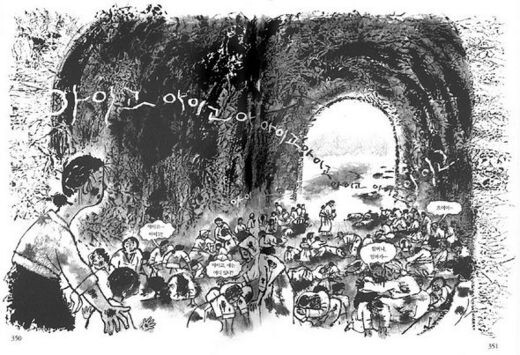hankyoreh
Links to other country sites 다른 나라 사이트 링크
Nogeun-ri excavations begin

Excavations began on the remains of people killed by U.S. forces during the Korean War at Nogeun-ri has begun.
A team lead by professor Park Seon-ju of Chungbuk National University performed a preliminary earth surface survey May 8 ahead of the excavation of the remains of those who were killed at Nogeun-ri, at a railway near Hwanggan-myeon, Yeongdong-gun, North Chungcheong Province. Ten survivors, including the vice chairman of the survivors' organization, were allowed to be present and members of the general public were denied access.
In July 1950, at the early stage of Korean War during 1950-1953, many refugees were killed near Nogeun-ri by U.S. soldiers, who believed there were North Korean spies among them.
The investigation centered on places presumed to be burial sites, including a hill identified by a 72 year-old Nogeun-ri resident. Professor Park and members of the Chungbuk National University's Remains Excavation Center examined soil ingredients on the hill.
"The excavation of remains from the Nogeun-ri massacre is the first step toward clarifying the truth of the incident," said Jeong Gu-do, vice chairman of the survivors' organization. "It is regrettable that the U.S. is not participating in the excavation even though we suggested that to the Korean Foreign Ministry in March."
"The excavation of the remains is attracting national interest and is a sensitive issue between South Korea and the United States, so need to be careful and we do feel a burden.," said Park. "We will do our best to investigate thoroughly and excavate the remains in detail."
As soon as the surface survey is complete, the North Chungcheong Province and Yeongdong-gun governments are going to commence on excavating the remains. To that end, the two governments plan to prepare a 200-million-won (US$ 216,000) budget and excavate until the end of the year.
When the remains are excavated, North Chungcheong Province and Yeongdong-gun will confirm their identity through DNA testing and then lay body of the deceased at a joint grave close to a historical park to be created on a 120, 000-sq.m. near the twin-cave bridge.
"The plan is to continue until the end of the year, but it would be best to be done by the rainy season," said Jeong, of the survivors' organization. "We are going to be in close consultation with the excavation team about the time and direction of the effort."
Please direct questions or comments to [englishhani@hani.co.kr]
Editorial・opinion
![[Guest essay] The real reason Korea’s new right wants to dub Rhee a founding father [Guest essay] The real reason Korea’s new right wants to dub Rhee a founding father](https://flexible.img.hani.co.kr/flexible/normal/500/300/imgdb/original/2024/0423/8317138574257878.jpg) [Guest essay] The real reason Korea’s new right wants to dub Rhee a founding father
[Guest essay] The real reason Korea’s new right wants to dub Rhee a founding father![[Column] ‘Choson’: Is it time we start referring to N. Korea in its own terms? [Column] ‘Choson’: Is it time we start referring to N. Korea in its own terms?](https://flexible.img.hani.co.kr/flexible/normal/500/300/imgdb/original/2024/0423/3617138579390322.jpg) [Column] ‘Choson’: Is it time we start referring to N. Korea in its own terms?
[Column] ‘Choson’: Is it time we start referring to N. Korea in its own terms?- [Editorial] Japan’s rewriting of history with Korea has gone too far
- [Column] The president’s questionable capacity for dialogue
- [Column] Are chaebol firms just pizza pies for families to divvy up as they please?
- [Column] Has Korea, too, crossed the Rubicon on China?
- [Correspondent’s column] In Japan’s alliance with US, echoes of its past alliances with UK
- [Editorial] Does Yoon think the Korean public is wrong?
- [Editorial] As it bolsters its alliance with US, Japan must be accountable for past
- [Guest essay] Amending the Constitution is Yoon’s key to leaving office in public’s good graces
Most viewed articles
- 1[Column] ‘Choson’: Is it time we start referring to N. Korea in its own terms?
- 2Why Korea shouldn’t welcome Japan’s newly beefed up defense cooperation with US
- 3Senior doctors cut hours, prepare to resign as government refuses to scrap medical reform plan
- 4[Guest essay] The real reason Korea’s new right wants to dub Rhee a founding father
- 5[Column] The clock is ticking for Korea’s first lady
- 6Opposition calls Yoon’s chief of staff appointment a ‘slap in the face’
- 7Terry Anderson, AP reporter who informed world of massacre in Gwangju, dies at 76
- 8New AI-based translation tools make their way into everyday life in Korea
- 9Samsung barricades office as unionized workers strike for better conditions
- 10Korean government’s compromise plan for medical reform swiftly rejected by doctors